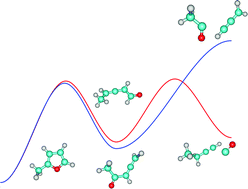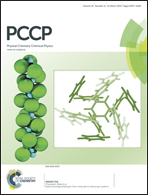The pyrolysis of 2-methylfuran: a quantum chemical, statistical rate theory and kinetic modelling study†
Abstract
Due to the rapidly growing interest in the use of biomass derived furanic compounds as potential platform chemicals and fossil fuel replacements, there is a simultaneous need to understand the pyrolysis and combustion properties of such molecules. To this end, the potential energy surfaces for the pyrolysis relevant reactions of the biofuel candidate 2-methylfuran have been characterized using quantum chemical methods (CBS-QB3, CBS-APNO and G3). Canonical transition state theory is employed to determine the high-pressure limiting kinetics, k(T), of elementary reactions. Rice–Ramsperger–Kassel–Marcus theory with an energy grained master equation is used to compute pressure-dependent rate constants, k(T,p), and product branching fractions for the multiple-well, multiple-channel reaction pathways which typify the pyrolysis reactions of the title species. The unimolecular decomposition of 2-methylfuran is shown to proceed via hydrogen atom transfer reactions through singlet carbene intermediates which readily undergo ring opening to form collisionally stabilised acyclic C5H6O isomers before further decomposition to C1–C4 species. Rate constants for abstraction by the hydrogen atom and methyl radical are reported, with abstraction from the alkyl side chain calculated to dominate. The fate of the primary abstraction product, 2-furanylmethyl radical, is shown to be thermal decomposition to the n-butadienyl radical and carbon monoxide through a series of ring opening and hydrogen atom transfer reactions. The dominant bimolecular products of hydrogen atom addition reactions are found to be furan and methyl radical, 1-butene-1-yl radical and carbon monoxide and vinyl ketene and methyl radical. A kinetic mechanism is assembled with computer simulations in good agreement with shock tube speciation profiles taken from the literature. The kinetic mechanism developed herein can be used in future chemical kinetic modelling studies on the pyrolysis and oxidation of 2-methylfuran, or the larger molecular structures for which it is a known pyrolysis/combustion intermediate (e.g. cellulose, coals, 2,5-dimethylfuran).


 Please wait while we load your content...
Please wait while we load your content...